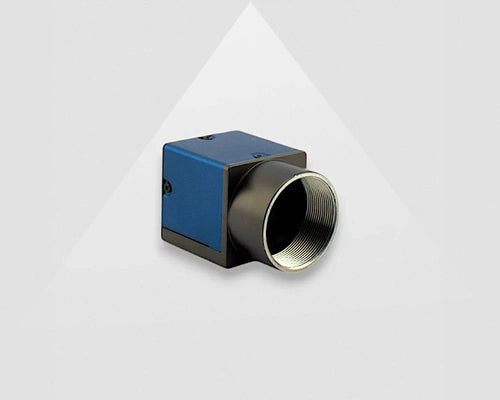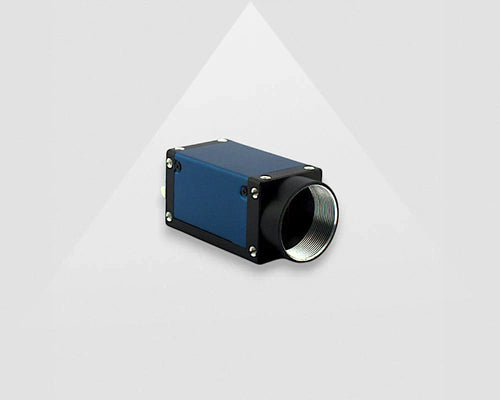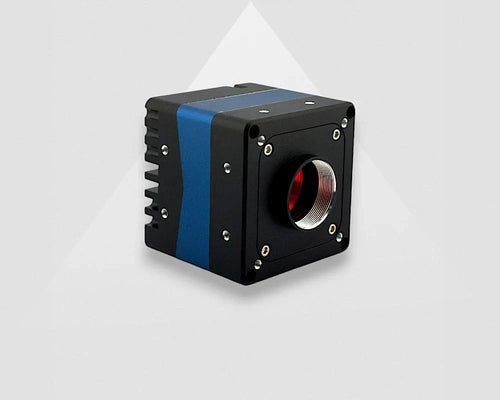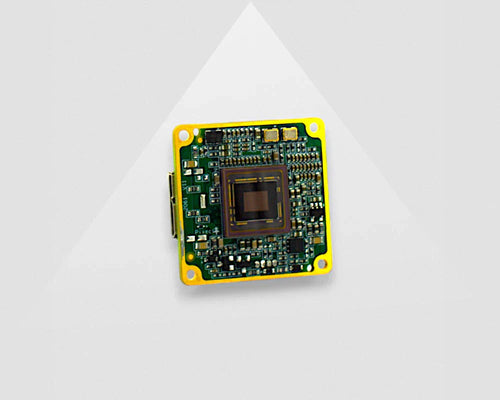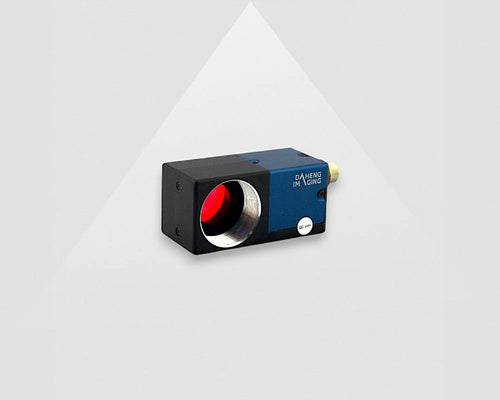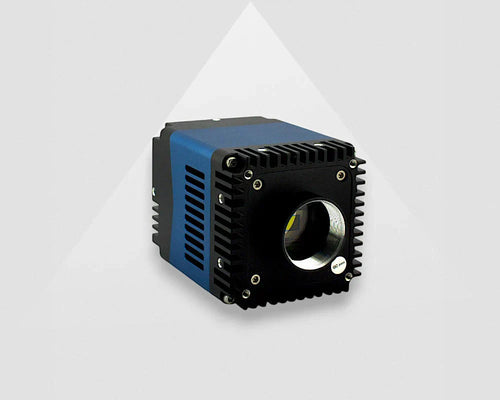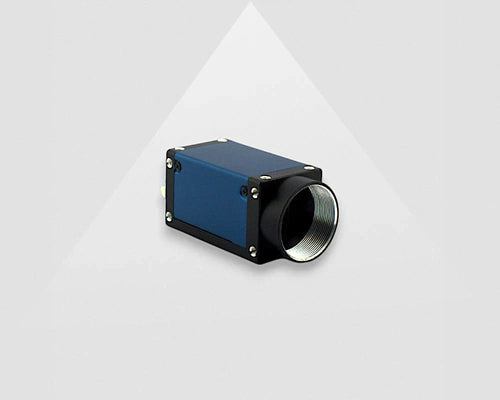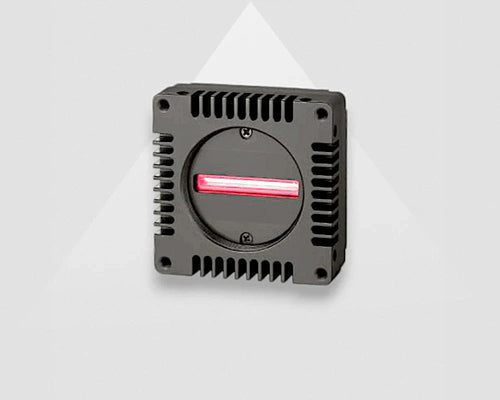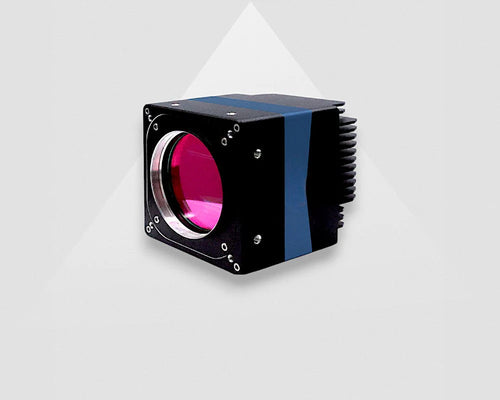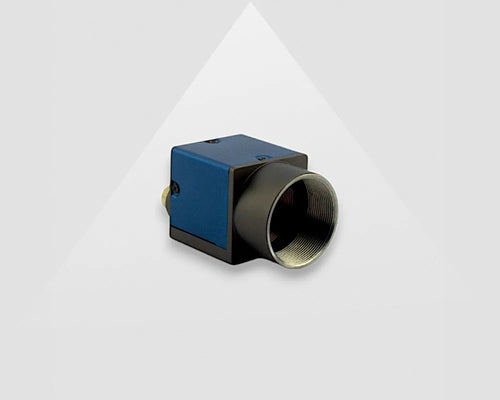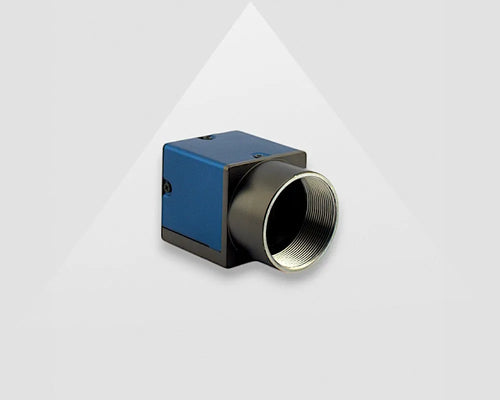
Industrial Cameras
Top 5 industrial camera interfaces
There are many industrial cameras, also known as machine vision camera, interfaces available. The following table shows a summary of the most common interfaces. Except Camera Link all interfaces are supported by industrial cameras from VA Imaging.
| USB2 | USB3 | GigE | Camera Link | Coaxpress | 5GigE | 10GigE | |
|---|---|---|---|---|---|---|---|
|
Supported by VA Imaging |
Yes |
Yes |
Yes |
Yes |
Yes |
Yes |
Yes |
|
Bandwidth |
40 |
400 |
100 |
Base=250 Medium=500 Full=750 |
1lane=750 2lane=1500 4lane=3000 |
500 |
1000 |
|
Cable length (maximum) |
5m |
4.6m; 100m with fiber |
100m |
100m |
7m |
50m |
50m |
|
Power + data on one cable |
Yes |
Yes |
Only if PoE |
PoCL |
Yes |
Only if PoE |
Only if PoE |
|
Frame-grabber mandatory |
No |
No |
No |
Yes |
Yes |
Yes |
Yes |
|
Cable costs |
Low |
Low |
Low |
High |
Low |
Low |
Low |
|
Camera costs |
Very low |
Low |
Low |
High |
High |
Medium |
Medium |
|
CPU usage |
Medium |
Low |
Meduim |
Low |
Low |
Low (special framegrabber) |
Low (special framegrabber) |
|
Multiple cameras |
Fair |
Excellent |
Good |
Fair |
Excellent |
Excellent |
Excellent |
|
Customer acceptance |
Fair |
Good |
Good |
Declining |
Fair |
Growing |
Growing |
What is the bandwidth of an industrial camera?
The first topic we will discuss is the bandwidth of an industrial camera interface. Simply said is bandwidth a way to measure the amount of data that can be sent between computers during a specific period. In terms of industrial cameras, this concerns the amount of image data that can be sent from the industrial camera to a host controller. Bandwidth is measured in megabytes per second, which means that an USB2.0 industrial camera can send image data equivalent to 40 megabyte each second.
This also means that an USB 3.0 camera interface(if used at full capacity) can send image data equivalent to 400 megabyte per second, which is around 10 times more than USB 2.0 industrial camera interface. When sending large amount of data (large bandwidth usage), it also takes the computer more time to process this data. As a result, it takes longer for the computer to reconstruct an image. However, a large bandwidth makes the data transfer faster, allowing the host controller to start calculating and reconstructing images earlier and faster. This is often required in industrial camera applications.
Industrial camera interfaces
The USB2.0 camera interface is the cheapest and easiest to use of all 3 options. Nevertheless, bandwidth and cable length are limited. USB2.0 Industrial imaging cameras are ideal for applications which require a maximum of 1.3MP at 30fps or 5MP at 7fps, with a cable length that does not exceed 5 meters.
The USB3.0 Vision industrial camera interface supports a bandwidth of 400 megabyte per second, and it uses the least amount of computer processor power. Therefore, it is ideal for high resolution and high-speed imaging. The cable length, on the other hand, is limited to 4.6 meters, but we offer high-quality active cables which go up to 50 meter.
The GigE Vision camera interface is often used in machine vision applications, which require longer cable lengths (>5m). The bandwidth of 100 megabyte per second is average (between USB2.0 and USB3.0). This makes it ideal for most machine vision applications. VA Imaging offers a wide portfolio of GigE Vision industrial cameras, with low to high resolutions.
The 5GigE Vision Camera interface requires a 5GigE or 10GigE network card to operate at full speed. It is using the same cable infrastructure as GigE. This interface is very interesting for industrial camera applications where long cable lengths and high frame rates with high resolutions are required as it offers a bandwidth 5 times higher than 1GigE industrial cameras.
10GigE Vision cameras require a 10GigE infrastructure. It has the highest GigE bandwidth VA Imaging offers currently. However, the interface is also relative expensive. For most of the industrial camera applications, GigE, 5GigE and USB3 will deliver a sufficient bandwidth.
CoaXPress cameras require a CoaXPress frame grabber. It has one of the highest bandwidth. However, the interface is also relative expensive. In most industrial camera applications, 5GigE, 10GigE and USB3 will be sufficient. Feel free to contact us for any advice.
Industrial Camera Technology
Industrial cameras, also known as industrial imaging cameras or machine vision cameras are designed for industrial and medical applications. The main differences between an industrial camera and a security or consumer camera are:
An industrial camera gives out the RAW information, without image compression.
Very low latency between image capture and image received by the PC
Option to exactly trigger the moment that the image should be captured with industrial cameras
Longevity, industrial cameras have a minimum life time cycle of 5-7 years (as most of the time even longer), while security and consumer cameras have a life time cycle of 1-2 years
Image-sensor-sensitivity, industrial cameras have larger and therefore more light sensitive sensors. As a result the images are better during low light conditions or short exposure times
With a industrial industrial camera you have access to more features, for example LUT tables, region-of-interest, triggering, pixel-binning etc.
Industrial camera applications
In almost every market, industrial cameras are used. Some examples are:
Reviews industrial cameras
-
8Cameras are a great value for money
The cameras are a great value for money and the lenses also. The software is outdated and needs refreshing. It took me considerable amount of time to discover how to access the camera features. The cameras are a great value for money and the lenses also. The software is outdated and needs refreshing. It took me considerable amount of time to discover how to access the camera features.
-
10Excellent quality material and attentive and reliable supplier
In the commercial phase we had maximum support and delivery times were respected. The material is quite good with low and competitive costs. In the commercial phase we had maximum support and delivery times were respected. The material is quite good with low and competitive costs.
-
10Fast cable delivery
I had ordered a camera but forgotten to include the required cable. the cable was ordered and delivered very fast. I had ordered a camera but forgotten to include the required cable. the cable was ordered and delivered very fast.
-
8Fast delivery
Fast delivery even without paying the speed premium Fast delivery even without paying the speed premium
-
9Fast Delivery and good quality!
A very good company, I will continue to cooperate next time! A very good company, I will continue to cooperate next time!
-
10Fast service
Extremely fast service. I got the camera next day. Highly recommend the seller! Thank you! Extremely fast service. I got the camera next day. Highly recommend the seller! Thank you!
-
8.5Good Experience
Top, good experience. Very attentive and quick to respond. Product arrived in good condition. Top, good experience. Very attentive and quick to respond. Product arrived in good condition.
-
8Good quality and fast delivery
So far, all components meet expectation, it would be great, though, if 3d models for all components were available. So far, all components meet expectation, it would be great, though, if 3d models for all components were available.
-
10Great customer support, products and prices
I contacted GeT Cameras to help out with selecting the best camera and lens solution for me. They provided great support. I ordered with express and received the products 2 days later :) I contacted GeT Cameras to help out with selecting the best camera and lens solution for me. They provided great support. I ordered with express and received the products 2 days later :)
-
9Great prices, great service, everything great
Bought quite a few cameras from these guys, prices are great, service is great, delivery times of the hardware is also very nice. Bought quite a few cameras from these guys, prices are great, service is great, delivery times of the hardware is also very nice.
-
10Great products. Excellent support.
GeT Cameras in Germany made some photo's of our products to show the performance of their cameras and they looked perfect. Recently we purchased a camera with lens, and LED lights. We are not exper... GeT Cameras in Germany made some photo's of our products to show the performance of their cameras and they looked perfect. Recently we purchased a camera with lens, and LED lights. We are not experienced with machine vision but the installation worked out fine. After installation on our laboratory we were surprised again of the high quality of the photos and the versatility of this system. (options in Galaxy viewer and integration in Python. Recently we had an issue with the software and the customer support was able to give us the relevant information to fix it within one day. The next time we need a camera we will not be looking to other suppliers but contact GeT Cameras immediately.
-
10Great support and inhouse knowledge of the cameras
First I was a little bit sceptic about buying online industrial cameras. It’s a critical part for our machine. For a new product development there was a lot of price pressure. We needed a cheap cam... First I was a little bit sceptic about buying online industrial cameras. It’s a critical part for our machine. For a new product development there was a lot of price pressure. We needed a cheap camera. I called them and Caspar was providing great support. He even advised a cheaper camera than I had in mind. I was just surprised by the inhouse knowledge of get cameras about machine vision. Never expected this from a webshop. The image an built quality of the camera is also great. The camera feels and operates the same as our Basler cameras.
-
10Great support by email
I ordered a 20MP USB3 camera including a lens 2 months ago for a datamatrix code reading application. In the beginning I was sceptic because of the low prices, but support by email was great. They ... I ordered a 20MP USB3 camera including a lens 2 months ago for a datamatrix code reading application. In the beginning I was sceptic because of the low prices, but support by email was great. They advise a lens and provided additional technical information. Unfortunately they don't offer a loan service, but I decided to try it. I had the cameras in house within 2 weeks and connection was easy. The SDK looks like the SDK from Basler so I felt directly comfortable with it. The camera and lens was a perfect match and now I'm able to read small DMC codes on large products with just a single camera.
-
10Great support while selecting a lens
We have bought a 20MP camera and lens with extension tubes to use it as a digital microscope in our lab. The support with selecting a lens was great. Connecting the USB3 camera was easy. We receive... We have bought a 20MP camera and lens with extension tubes to use it as a digital microscope in our lab. The support with selecting a lens was great. Connecting the USB3 camera was easy. We received everything on time.
-
10High quality
High quality components and service! My order was handled quickly and arrived ahead of schedule. Would recommend. High quality components and service! My order was handled quickly and arrived ahead of schedule. Would recommend.
-
10It is important to have a skilled and efficient team of workers to get the goods efficiently.
Maintained a good relationship and very good communication from start to finish to purchase the item. Maintained a good relationship and very good communication from start to finish to purchase the item.
-
9Outstanding products and customer service
The customer service staff was friendly, easy to approach and helped us select the appropriate products which fit our use case perfectly. The customer service staff was friendly, easy to approach and helped us select the appropriate products which fit our use case perfectly.
-
10Outstanding products and customer service
Get Cameras were extremely kind to sponsor us with some amazing equipment for our RoboCup student team, Delft Mercurians. We had no issues with the cameras, they perform as advertised and enabled u... Get Cameras were extremely kind to sponsor us with some amazing equipment for our RoboCup student team, Delft Mercurians. We had no issues with the cameras, they perform as advertised and enabled us to continue with the project and the company was extremely supportive of us overall. The customer service staff was friendly, easy to approach and helped us select the appropriate products which fit our use case perfectly.
-
8Perfect customer interaction
Good site and perfect customer interaction. Good site and perfect customer interaction.
-
10Products delivered sooner than promised
Ordered products were delivered sooner than promised, all ordered items were included in the package and we had no problems to make them work (cameras work with the attached software and with Matlab). Ordered products were delivered sooner than promised, all ordered items were included in the package and we had no problems to make them work (cameras work with the attached software and with Matlab).
-
10Professional support, fast delivery and good product.
I liked that your team helped me chose the needed equipment by my description. The items that i have ordered are exactly what i have looked for. I liked that your team helped me chose the needed equipment by my description. The items that i have ordered are exactly what i have looked for.
-
10Prompt responses to many questions
Prompt responses to our many questions. A good selection of cameras despite shortages elsewhere in the industry and we have been able to specify some of these cameras to keep projects moving forwar... Prompt responses to our many questions. A good selection of cameras despite shortages elsewhere in the industry and we have been able to specify some of these cameras to keep projects moving forward. We continue to buy regularly.
-
10Quick responses and good selection of cameras
Prompt responses to our many questions. A good selection of cameras despite shortages elsewhere in the industry and we have been able to specify some of these cameras to keep projects moving forwar... Prompt responses to our many questions. A good selection of cameras despite shortages elsewhere in the industry and we have been able to specify some of these cameras to keep projects moving forward. We continue to buy from Get-Cameras regularly.
-
10Quick shipping and excellent customer service
The customer service is quick, friendly and helpful, shipping takes place fast and the quality of cameras and accessoires is excellent. Very useful is also the provided software, including coding e... The customer service is quick, friendly and helpful, shipping takes place fast and the quality of cameras and accessoires is excellent. Very useful is also the provided software, including coding examples to implement the cameras in our systems.
-
10Quick shipping and excellent customer service
The customer service is quick, friendly and helpful, shipping takes place fast and the quality of cameras and accessoires is excellent. Very useful is also the provided software, including coding e... The customer service is quick, friendly and helpful, shipping takes place fast and the quality of cameras and accessoires is excellent. Very useful is also the provided software, including coding examples to implement the cameras in our systems.
-
9Suitable product for us
We already have several of your cameras. These are for stock only. Since we are taking them into stock, that means we are happy with them. Only lead time is little bit longer. We already have several of your cameras. These are for stock only. Since we are taking them into stock, that means we are happy with them. Only lead time is little bit longer.
-
10Very good value for money
The camera arrived on schedule and gives excellent images. Very good value for money. The SDK makes it very easy to acquire images into a program of my own written using C++Builder (about 2 hours p... The camera arrived on schedule and gives excellent images. Very good value for money. The SDK makes it very easy to acquire images into a program of my own written using C++Builder (about 2 hours programming).
-
10Very helpful customer service
We needed a vision camera for our project very urgently. They where able to deliver it in a few days time. They responded quick to my emails also when I needed support. They send me an article how ... We needed a vision camera for our project very urgently. They where able to deliver it in a few days time. They responded quick to my emails also when I needed support. They send me an article how to quickly install the camera and set the most important parameters. it was very helpfull and within half an hour we had a good live view image. We have also ordered the lens they advised. It provides a nice and sharp image.
Vision & Automation Resources
-
FAQ pageFAQ
Most common questions are already answered on our FAQ page. Questions about delivery times, warranty, loan, returns, longevity, manuals etc.
-
DiscoverImaging Software
Image processing software captures the images from an industrial camera and performs complex image processing tasks like segmentation, detection, code and text reading.
-
DiscoverKnowledge Center
We share our machine vision knowledge in our knowledge center. Find tutorials how to connect cameras, install software & program I/O.
-
DiscoverMachine Vision Applications
Check how our customers use our industrial cameras, lenses and lighting in their application
-
Talk to usMachine Vision Experts
Ask our machine vision experts! We answer rapidly and think along with your imaging project.
-
DiscoverDownloads
Image processing software captures the images from an industrial camera and performs complex image processing tasks like segmentation, detection, code and text reading.
















































